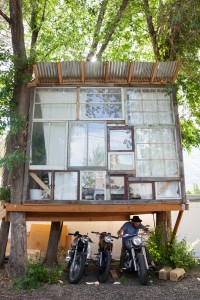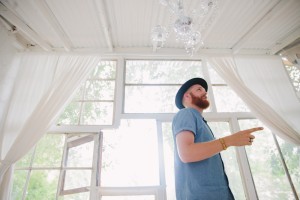
Some people look at worn-out windows and old siding and all they see is junk, but to someone like Quinn Peterson, even the most mundane things have creative value.
Peterson’s backyard treehouse, made largely of recycled material, is proof of that.
“I just kind of make what I need for life,” Peterson said.
Peterson, an entrepreneur and BYU student, makes his own shoes and home furniture, renovates old houses and restores retired motorcycles. Peterson does the same thing for his business as he does for fun, creating things with his hands. His company, QP Collections, is an online store where he sells his hand-made goods.
Peterson said he receives inspiration for his projects from odds and ends he collects. He compiled an array of tools and leftover construction materials from the two years he spent renovating his house, located near 400 East and 300 South in Provo. It didn’t take him long to figure out what to do with it.
“I had a lot of windows and I had a lot of wood, and I’ve always wanted a treehouse,” Peterson said.
He hit a few roadblocks along the way, like getting permission from the City of Provo to build the structure. It had to be accessible via ladder, and its weight had to be fully supported by the tree, or in Peterson’s case, the five trees.
Peterson admits a project like this should have taken three to four months, but he did it in three weeks, doing most of the construction on his own.
He built the main structural parts with help from his friend Ken Adkins, a junior from San Diego, California, studying philosophy. Peterson and Adkins have worked together a lot ever since they served as mission companions in Tennessee.
Adkins said past projects, like building furniture and rebuilding Peterson’s home, helped them feel confident they could build the treehouse. Others worried about its stability, especially because they built the whole base in one night. They managed, in the end, to construct a stable, fully-suspended treehouse supported by the five trees surrounding it.

“Usually I help out as much as reasonable. But there were a couple of nights that I was there until two in the morning,” Adkins said.
Adkins believes it is every person’s desire to create or make something new. Creation and innovation have been part of Peterson’s life since he was a child. He and his family spent a lot of time shopping at thrift stores and second-hand shops when he was a child.
“It’s probably because my parents didn’t have any money,” he said. “But we just thought it was cool.”
He doesn’t know exactly how he got into making things, but he remembers being particular about how his clothes fit. He found a sewing machine in his basement and taught himself to alter clothing. Peterson couldn’t find any neckties he liked while preparing for his mission, so he made his own. His neckties were the start of his future business.
Peterson was skeptical that people would actually buy his product in a store, so he set up an etsy.com shop in 2011.
“When somebody says, ‘Oh that’s really cool. I’d buy that,’ they’re usually full of bologna,” Peterson said. “They are just impressed you made it, especially because I’m a boy.”
His business started off slow, but sales eventually rose. He began selling ties made from old, uniquely patterned clothing, which attracted retailers who wanted to buy in bulk. He transitioned from his etsy.com shop to his own website, qpcollections.com, to accommodate the growth in 2012.
Peterson made patterns, expanded his inventory of materials, purchased more machines and hired a team to perfectly replicate his work on a large scale. Peterson’s sister, Joelle Mittanck, a 24-year-old student studying dietetics, works as the company’s head seamstress.
“Quinn will give me cool fabrics, and I am always so excited to see how it will turn out,” Mittanck said. “It kind of makes my job fun because I’m the first one to see it done.”
Peterson recently launched a new product line of handmade canvas and leather bags called QP Venture Collections. Its production incurred heavy expenses, all of which the company paid outright. Peterson has yet to take out a loan to fund his ventures, and still, the company has never gone into debt.
“I think it’s a lot easier to fail as a company when you get money,” Peterson said. “You don’t have as much trial and error, and you don’t have as much struggle to find what’s going to work.”
Peterson remains disciplined in working with tight finances. He said it wasn’t until recently that he could afford to buy his own handmade bag. Despite financial setbacks, his company continues to grow, with plans to expand product.
QP Collections and Peterson’s unique furniture are currently sold at Unhinged in Provo. He has picked up interest outside the United States, 40 percent of online sales being international.
Additionally, he has been working with an non-governmental organization, buying hand-woven fabric from four different weavers in Ghana. These neckties are sold in his “Kente” line. Twenty percent of proceeds are going toward building a structure, enabling these weavers to work indoors.
No one knows what he will build next in his leisure time, but Peterson has attained success, so far, by being willing to try new things and step into the unknown.
“Something I’ve learned from Quinn is don’t be afraid to try,” Adkins said. “Don’t be afraid to mess up.”




